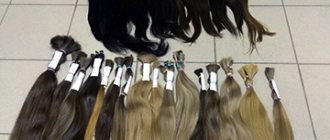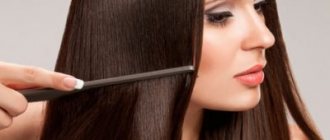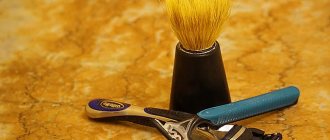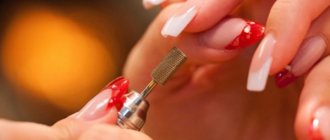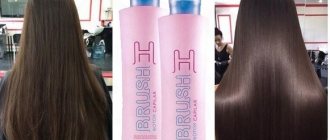One of the most popular hair extension methods today is hot capsule extensions . This technology has quickly gained popularity among women around the world due to its ease of wearing and amazing results. The capsule technique makes it possible to achieve the most natural effect. Now the original technology is widely used in beauty salons and extension studios around the world, and this is despite the actual evolution of this method into a more harmless and high-quality one - microcapsule extensions.
Professionals and clients also like to call this technology Italian hair extensions. Let's look at the origins, pros and cons of this technology.
tongs for hot capsule hair extensions
The hot capsule extension method itself was presented to the world by David Gold, a well-known hairdresser and stylist abroad. The man was tired of the constant complaints from his clients about the fact that the capsules (resin), which are traditionally used in the English method, do not hold the extension strands securely. That is why, back in 1991, David invented his personal method by which you can lengthen your hair using keratin capsules.
What is “capsule hair extensions”
The desire of women to change and improve, to take care of their appearance and attend various salon procedures is wonderful. Hair extensions are exactly one of the salon procedures that help the fair sex change their appearance and image.
Capsule extensions are a method of attaching natural donor strands to the client’s hair. They are attached to so-called capsules, hence the name of the method. Most often, craftsmen use capsules of one of two types - keratin or adhesive, less often - resin. Capsule extensions can be cold or hot. These methods differ in the presence or absence of heat treatment of the capsules during the procedure.
It is worth noting that this procedure, in addition to adding length to the hair, also makes it much thicker, which is its undoubted advantage. The extension method using capsules is popular, simple, affordable and safe. And most importantly – effective.
Is it possible to do hair extensions at home?
For home extensions using hot technology, you will need heating tongs, strands and a thin comb. Using a comb, you need to make a neat circular parting.
Afterwards, all the hair along the parting should be alternately divided into identical strands, attaching artificial ones to them. The forceps used to clamp the capsules will help you do this. Similarly, the entire area of the head should be divided into circular partings, gradually filling it.
Cold extensions are also performed using circular partings. The difference is the use of a separator that secures the strands. Donor strands are attached with glue, which eliminates the need to use forceps.
Read more about types of capsule extensions
There are 2 main types of capsule extensions - hot and cold . Masters separately distinguish another 3rd type - ultrasonic extension , since in this case the capsules are heated, but it is completely insignificant, while with hot extension the capsules are heated to 150-200°C.
Types of hot hair extensions on capsules
Italian – refers to a hot type of procedure. The essence of this technology is to attach donor strands to the client’s hair using heated keratin capsules. The strands join the hair almost at the roots. It is worth noting that high-quality work by a qualified craftsman presupposes a complete match of the donor strands with the client’s natural hair and the absolute invisibility of the capsules. An undoubted advantage of this type of extension is the hypoallergenic nature of the materials. It is worth noting that this is a rather long procedure, it can take up to 5 hours.;
English is also a type of hot extension. It consists of attaching strands to the hair using a special glue gun and resin. Due to the fact that the hot resin hits only the donor strands, the client’s hair is not negatively affected. Professionals note that this type of extension has less wear than using keratin capsules. At the same time, the procedure itself also takes less time – up to 3 hours. Experts say that this method of extension is completely unsuitable for lengthening hair in the bangs and temples;
Microcapsule also refers to hot technology. The essence of the procedure is almost the same as in Italian extensions; the capsules are also keratin. However, the size of capsules with microcapsule extensions is 2 times smaller than with conventional keratin extensions. Thanks to this, the gap between corrections is longer than with other types of extensions. This method is also considered the safest for a young lady’s own hair;
Spanish cold extension
Capsule extensions using the Spanish technique involve the use of two-component glue to attach strands. The capsules are quite small and almost invisible. Masters do not recommend performing this procedure if the client has short hair. This procedure refers to the cold type. Its cost is somewhat lower than that of Italian and English extensions, although it requires more labor and lasts about 4 hours;
Ultrasonic extension
The essence of ultrasonic extensions is that the capsules are softened before being attached to the client’s hair using a special ultrasonic device. Professionals usually do not classify this type of extension as cold or hot, since the capsules are heated, but not to the same temperatures as with hot extensions. Ultrasonic extension takes about 2 hours. According to the experts, it is the safest and even, moreover, prevents the loss of both donor strands and your own.
Who is it suitable for?
To determine whether capsule hair modeling technology is suitable for a particular girl, you need to get a preliminary consultation with a hair stylist.
There are a number of factors in which the procedure is contraindicated in principle. If extensions are acceptable, then traditionally hot methods are not recommended for girls with thin and weakened hair.
The length of hair at which one or another method is possible is also different. Some methods of attaching capsules allow you to grow curls even with a short haircut (several centimeters long), but sometimes you will need to grow the required length of 15-25 cm.
Types of donor strands
The capsule extension procedure involves the use of only natural donor strands. This is one of the criteria that determines the fairly high price of the procedure. At the moment, craftsmen use 4 main types of donor strands:
Slavic curls are of high quality and lack any chemical treatment. The most expensive type of material.
Asian curls . Often, these are strands of medium and low quality, respectively, they are much cheaper than Slavic ones. They are used if it is necessary to increase the length of the client’s hair by more than 60 cm.
European curls . Such strands have been repeatedly exposed to chemical processes. Their selection occurs in the direction of the curls. It is worth noting that due to low quality and constant exposure to chemicals, European strands cannot be corrected.
South Russian curls . This type of curl extensions falls into the middle price category. Its advantage is that it has not been subjected to chemical treatment, but its quality is lower than that of the Slavic type. The wearing period is 1 year.
It is worth understanding that when choosing donor material for hair extensions, you need to pay attention not only to the price, but also to the quality, structure, and color. You should choose strands in such a way that they are as similar as possible to the client’s natural hair.
Variety of techniques
Capsules for the purpose of lengthening hair are used in accordance with several technologies.
Italian
Instructions:
- As a base, ready-made strands are taken with a keratin capsule fixed at the base, which is small in size and therefore almost invisible.
- This technology provides the possibility of lengthening the hair not only in the occipital and temporal region, but even in the bangs. If desired, the girl can remove it.
- It is possible to complement the hairstyle with strands of various colors, African braids or rhinestones.
- An important advantage is that it is not afraid of styling, hot air from a hair dryer and direct rays of the sun.
- The approximate wearing period is from 4 to 6 months.
English
How to do it:
- The master creates artificial curls with his hands, and the capsule consists of organic resin, which is heated with a glue gun.
- This technology is characterized by a high level of complexity and execution time.
- Compared to the Italian method, the capsule that connects the donor curls with the native strands is larger.
- There is no way to lengthen the bangs.
- The procedure cannot be performed on oily curls.
- The approximate wearing period is from 3 to 5 months.
Microcapsule
Peculiarities:
- This technique allows you to reduce the load on natural curls, since microcapsules are used for extensions.
- A distinctive feature is thin strands in comparison with the standard procedure. The specialist distributes one standard bundle into smaller strands.
- Thanks to this technique, the junction of donor and natural curls is almost invisible.
- It is possible to lengthen the bangs.
- The procedure is suitable even for those with lifeless, thin and brittle hair.
Advantages and disadvantages of capsule hair extensions
Like any other cosmetic procedure, capsule extensions have their advantages and disadvantages. Girls who have used this method of hair extensions and hairdressers talk about the following advantages:
Natural looking hairstyle . Thanks to the competent selection of strands, as well as the ability to color them, straighten/curl them, they are practically no different from the client’s natural hair;
Invisibility of capsules . If the procedure is performed well and the materials are good, the capsules are completely invisible, which gives the hair a natural look and does not make combing difficult; the ability to achieve absolutely any hair length, depending on the client’s wishes;
Thermal stability of capsules . For many young ladies, the ability to heat style is extremely important. With capsule extensions, you can safely use a hairdryer, curling irons, straighteners, etc., without fear of damaging the capsules;
Resistance of capsules to external factors . Another advantage of capsule extensions is that they have virtually no restrictions on wear, i.e. with hair extensions using this method, you can swim in the pool and open reservoirs, visit saunas and solariums;
Ability to create a wide variety of hairstyles . Hair extensions can be pulled into a ponytail, braided into different types of braids, styled with a hair dryer, etc.
Long wearing period . Depending on the type of capsule extension, between corrections it takes from 1.5 to 5 months.
The disadvantages of the capsule method of hair extensions are the following:
- hair extensions using the capsule method require a complete refusal to use products containing oils, lipid fats and acids. These substances gradually break down the capsules;
- Hair extensions must be combed frequently to avoid tangling of the capsules. This is not always convenient, because the rhythm of life of modern representatives of the fair sex is quite fast and intense. Finding time for regular quality brushing can be difficult;
- Another disadvantage of hair extensions is that you will have to give up massage combs and use exclusively combs. Firstly, it is not always convenient. Secondly, hair follicles, without massaging them with a comb, somewhat slow down the growth of natural hair;
- Girls also consider its high cost to be a significant disadvantage of capsule extensions. However, this cost is justified by the price of high-quality materials, tools and labor costs of a professional craftsman.
Pros and cons of the method
Modern capsule technologies are as safe as possible for girls. Although the techniques are developed taking into account the needs and capabilities of different types of curls, long-term extensions that are completely harmless to the native hair do not exist in principle.
The disadvantages of the capsule procedure include:
- The capsule (albeit slightly) disrupts the nutrition of native hair from the roots, which can cause brittleness and dryness.
- The hot fixation type means that the hair is exposed to high temperatures, which damages the hair.
- A ban on care products for extended curls containing oils and acids.
- There may be restrictions on visiting the bathhouse, sauna, solarium, and drying with a hot hairdryer.
The undeniable advantage of capsule extensions is the ability to create a hairstyle of any length and volume. The fastenings of the donor strands are very small and completely invisible to the prying eye. Typically, curls extended using the capsule method allow you to do any styling, including high ones.
Contraindications for capsular hair extensions
The capsule extension procedure has medical contraindications, which include:
- alopecia;
- frequent headaches and migraines;
- arterial hypertension;
- various diseases of the scalp (including seborrhea and dermatitis);
- oncological diseases;
- period of pregnancy and lactation.
All these contraindications are direct to the procedure of hair extensions using the capsule method. It is worth noting that taking hormonal medications, antibiotics, dry and damaged hair are also contraindications to the procedure.
Experienced specialists do not recommend undergoing extension procedures for several years in a row, since in this case your own hair may suffer and weaken. It is imperative to give your hair time to rest and recover. Therefore, regular, continuous wearing of hair extensions is also a contraindication to further undergoing the procedure.
Indications and contraindications
Capsule hair extensions have a number of indications and contraindications; below we will look at them in detail.
Indications for the procedure:
- Increasing hair length – capsule extensions can significantly lengthen hair. On average, you can achieve an increase in length from several tens of centimeters to a meter.
- Increasing the volume of hair - extended strands significantly increase the volume of the hair and give the hair fullness.
- Hiding imperfections - if you have any imperfections on your head associated with a lack of strands, for example, a receding hairline and bald spots, then capsule hair extensions can easily help solve this problem.
- Changing your image - growing hair on your own is a rather long and labor-intensive process. In addition, it is not always possible to achieve the desired result. Strand extensions help quickly fulfill the dream of long and voluminous hair, as in advertising for cosmetic care products.
Who should not get capsule hair extensions?
- Firstly, the procedure is contraindicated for weak, unhealthy hair, since extensions can only aggravate the current situation.
- Secondly, extensions are not performed for skin diseases. These include fungus, seborrhea, psoriasis, eczema, as well as the presence of fresh wounds and scratches on the head.
- Thirdly, extensions are not performed on teenagers and women during pregnancy, since at this time the hair becomes fragile and thin.
- Finally, this procedure is not recommended for persistent headaches, migraines, or undergoing chemotherapy.
Step-by-step instructions for capsule hair extensions
- First of all, you need to decide on the length and color of the extension strands and prepare them by selecting them according to the specified criteria. You should also choose the type of strands for extensions depending on the structure and color of the girl’s natural hair and price preferences.
- The next general step is to thoroughly wash the client's hair. In this case, you cannot use masks and balms, only gentle shampoos. It is worth noting that it is better to dye natural hair in advance and do it planned, taking into account that the capsule strands are attached to the back of the head and temples, avoiding the crown.
- Well-combed, clean, dry hair must be divided into zones - the marginal growth line, bangs, and parietal zone. Next, you need to distribute those parts of the hair to which the strands will be attached into thin curls - about 0.5-0.7 cm (the thinner the strand, the more natural the effect of the procedure will be) and secure them with special protective circles.
Subsequent actions depend directly on the chosen type of capsule extension:
Having chosen Italian extensions , ready-made donor strands are used with capsules attached to them, which must be heated using special tongs. The strands are attached almost at the roots.
Important! When attaching donor curls at a distance of more than 1 cm from the root, the capsules may become tangled and the entire hairstyle may have an unaesthetic appearance. Such a procedure is unacceptable! Moreover, in this case, correction will be required much earlier than if the capsules are attached close to the roots.
To carry out the procedure using English technology , curls formed by the master himself are used. They are attached to a special resin heated with a glue gun. Resin capsules are larger in size than keratin capsules, this should be taken into account when choosing the type of procedure.
Important! The extension process using English technology is quite complex, labor-intensive and time-consuming. Not suitable for oily hair, as well as for extensions in hard-to-reach areas - bangs, temples.
During Spanish hair extensions, the hairs of the strands are fastened together with a special glue that does not require heating, forming a kind of capsule. Then, with the same glue, the resulting donor strands are attached to previously prepared natural ones.
Important! This type of extension is not suitable for those with dark hair, since the glue becomes lighter after drying. This method is also not used on short haircuts.
microcapsule extension procedure requires special care. The process itself is identical to Italian extensions, but the strands (both natural and donor) are several times thinner and the capsules are smaller.
Important! The process of microcapsule extensions takes a long time and requires special care, but at the same time it gives the hair the most natural look.
ultrasonic extension procedure involves softening the strand capsules using a special ultrasonic device. In this case, donor strands are attached at a distance of 1 cm from the roots.
Important! This is the safest and most gentle type of extension, which is suitable for any type of natural hair and donor strands.
At the end of the procedure for any type of extension, the hair must be thoroughly combed with a comb. The first day after extensions, it is not recommended to overdo it with care procedures; you should avoid hair coloring and styling/hairstyles.
Reviews
Reviews about capsule extensions are mostly positive. Girls who have used this service note the ease of combing their extensions. The effect of the procedure lasts for a long time – at least 4 months. There is no discomfort or weight gain after performing it. Donor strands are easy to style and hold their shape well.
When dyed, hair extensions do not differ in shade from natural hair.
Encapsulation of donor strands
Encapsulation of strands is one of the processes of preparing for extensions. Its essence is to divide donor hair into strands and bind them with a keratin capsule. This procedure is performed when preparing strands for hot extensions.
All donor hair is divided into identical, thin bundles; their diameter should be approximately 5 mm, no more. Then it is necessary to form keratin capsules; they must be of the appropriate size - for standard capsule extensions - no more than 6 mm.
To form keratin capsules, you will need special forceps. You can perform the procedure by hand, but this is not always convenient. After separating a small amount of material from the total keratin mass, it needs to be “rolled” into a capsule, melted with thermal tongs and secured to a previously separated strand. This must be done carefully so as not to spoil the donor hair.
Before the process of directly attaching the capsule, the strands must be thoroughly combed and divided not only by the volume of the bundles, but also by length. You can also use special curling irons and apply a little keratin along the entire length to each individual strand; this will give the donor curls a more natural and healthy look.
After all the bundles are encapsulated, it is necessary to arrange them again in length - from short to long, carefully cut off excess hairs and protruding ends of the capsules (if any) with scissors. The final stage of the procedure is re-combing the donor strands that are ready for extension.
Important! Encapsulating strands requires a lot of labor, perseverance, patience and attentiveness of the master. It is better to engage in the process in a quiet, calm environment. Often, encapsulation is done on a large, clean table to provide space for laying out the strands.
Non-capsule extension
Non-capsule extensions - using special heat-shrink sleeves - small transparent tubes. The natural and donor strands are threaded into the tube with a hook, after which the structure is heated with tongs - this is how the hairs stick together.
Pros:
- Unlike capsules, sleeves create an almost invisible attachment point;
- Less harm, since the tongs act directly on the sleeve and not on the hair;
- By creating knots on the strands, accidental hair pulling is prevented;
- You can use any cosmetic products.
Minuses:
- You should not heat your hair too much, since at temperatures above 100 degrees the sleeve softens and, as a result, the adhesion deteriorates. The use of thermal appliances, as well as visiting baths and saunas, is prohibited.
How is capsule-free extension performed:
- The hair is parted horizontally;
- A small strand is separated and tied into a knot using a hook;
- Using the same hook, the resulting strand with a knot is pulled into the sleeve and a pre-encapsulated donor strand is inserted;
- The sleeve is clamped with tongs heated to 120 degrees.
The tubes used for extensions are made of breathable material that allows water and air to pass through, that is, the hair shafts under the sleeve will not be like in a greenhouse.
Removing hair extensions using the capsule method
You can remove hair extensions using the capsule method either in a salon, with the help of professionals, or at home. It is worth considering that salon technicians use professional materials and special tools in their work. Based on this, we can conclude that removing hair extensions by professionals is a more gentle method for the hair and scalp and takes less time, due to the experience of the specialist.
So, it is necessary to remove hair extensions after the natural ones have grown by about 5 cm. Professionals use special removal tongs and remover - a liquid that destroys the structure of keratin, making it possible to remove it from the hair.
First of all, the part of the hair where there are no extensions is separated and pinned. This is done so that the remover does not get on it. Next, liquid to remove hair extensions is applied directly to the capsules. Depending on the amount of work, the master can apply this liquid pointwise to each capsule or use a spray bottle to immediately cover a large area. The period of action of the liquid is 10-15 minutes, after which you can begin the procedure for removing the capsules.
Keratin is a fairly durable material. Therefore, in order to remove the capsule, it is necessary to use special crushing forceps. If the capsules are easily crushed with forceps, then you can safely continue the procedure, but if the crushing process is difficult, then you need to repeat the treatment of the capsules with a special remover again, applying it again and leaving it to act for 10 minutes.
After removing the capsules, the donor strands are very easily removed from the natural hair. After removing them, you need to carefully comb your hair with a wide-tooth comb to remove any remaining keratin from it, as well as any remaining hair from the extensions. If the hair is too tangled after the procedure, you can use various sprays for easy combing and oils.
Important! After removing the extensions, you must rinse your hair thoroughly. Remover is a chemical liquid and has a negative effect on the scalp - it dries, causes flaking, and also greatly degreases the hair.
When talking about home methods for removing capsular extensions, the “nasty” method is most often used. During extensions, each master warns his clients that all kinds of oils, lipid fats and acids, respectively, and all products containing them are contraindicated for hair extensions using the capsule method.
To carry out the removal procedure at home, you need to apply a generous amount of any base oil to your hair, and especially to the capsules - sea buckthorn, burdock, castor, etc. Leave it on your hair for 20 minutes to 1 hour. Due to the negative effect of oil on keratin, its structure will begin to disintegrate, and it will be possible to easily remove the extensions; the partially split capsule will slide through the hair.
There is also a home method for removing capsule extensions using a hair straightener. Professionals do not recommend using this method, because it can have an extremely negative impact on your own hair.
In order to remove the extensions using a straightening iron, it is necessary to carefully treat the area around the keratin capsules with thermal protection - both from the side of the natural hair and the donor strand itself. Heat the iron to 180 degrees. Then each capsule must be pressed separately with an iron, wait 40-60 seconds until the keratin melts and carefully, without releasing the plates of the iron, remove it, lowering it along your own strand. Remains of keratin are also combed out with a comb using some base oil.
Important! When removing capsule extensions with a straightener, there is a high probability of damage to your hair due to exposure to high temperatures over a long period of time.
Capsule layout
To secure the donor material, the master creates horizontal partings. Rows of capsules can be continuous or intermittent . After gluing each one, an indent of about 1.5 cm is made.
In some cases this distance is not maintained. The rows are placed close to each other if a woman wants to greatly increase the volume. Sometimes they resort to this when their own hair is very sparse.
Mistakes during capsule extensions
Mistakes made during hair extensions using the capsule method can lead to a variety of consequences - from an unaesthetic appearance of the final hairstyle to a significant loss of your own curls. The most common mistakes among beginners and those who do their own hair extensions at home are:
- hair that is not clean enough. It is very important to thoroughly wash your hair before the procedure, without using any masks, balms, oils, sprays, etc. If the hair is not cleaned enough, the capsule simply will not attach and will slide down the curl along with the donor strand. The same effect will occur when using tongs that are not heated to the required temperature;
- a poorly formed capsule will lead to poor fastening of the donor strand and, when combing, hairs will fall out of it;
- too high level of tension in the natural curl. With strong tension on natural strands, the capsules can press and prick the head when their wearer is in a lying position;
- incorrect assessment of the condition of the client’s natural hair. Perhaps this error occurs more often than others. It is an inadequate assessment of the hair condition of a girl who wants to have hair extensions that can lead to extremely negative consequences, including the development of alopecia;
- discrepancy between the thickness of your own strand and the extension. If the donor strand is much thicker than its own, then it will pull on the natural bun, which will lead to its refraction or loss.
Important! The biggest mistake is capsule hair extensions for representatives of the fair sex who have contraindications to this procedure.
Correction
Periodic correction of strands will be required with any extension technology, including capsule ones. To make the hairstyle look as natural as possible, and the places where the extensions are fixed are invisible, the donor hair is attached at a distance of a centimeter from the scalp.
As the native hair grows, the attachment line descends, and some of the donor strands may require replacement. Therefore, once every 1.5-3 months, the extended strands are completely removed, and then “re-extended” at the desired level (if necessary, updating part of the material, replacing donor strands and adhesive capsules).
Caring for capsule hair extensions
First of all, it is worth noting that hair extensions should never be combed with a massage brush; they can only be used with combs. The combing procedure should be carried out quite often so that the capsules do not get confused with each other.
Speaking about products for caring for hair extensions, the master recommends the use of professional lines - sulfate-free shampoos, light balms and sprays that do not contain any oils, lipid fats and acids.
When washing your hair extensions, you need to follow certain rules:
- before washing your hair, you need to comb your hair thoroughly;
- When washing your hair, you need to tilt your head back, otherwise the capsules may get tangled with each other, and it will be extremely difficult to separate them and comb your hair;
- It is better to use a shower for washing - there is less chance of hair tangling;
- Shampoo must be applied carefully, along the entire length of the curls, without rubbing into the roots, so as not to damage the capsules, the same applies to balms and masks.
After washing, under no circumstances should you “twist” your hair, wrap it in a towel and comb it until it is completely dry. You need to lightly blot them with a dry towel and dry naturally. Using a hairdryer is allowed, but requires applying a thermal protectant to the curls.
In order for the extended strands to look aesthetically attractive longer and to be reusable, you need to treat them with care, following all the rules of care, trying to cause as little chemical and mechanical damage as possible. Also, it is worth noting that it is better to exclude tight hairstyles and backcombing, giving preference to light braids and loose hair.
Care
To avoid having to make corrections ahead of schedule or remove donor strands altogether, they need care. A series of products has been released specifically for hair extensions - J-Line, which is sold in professional cosmetics stores. It contains everything you need for proper care:
- gentle cleansing shampoo;
- silicone oil for split ends;
- serum with hydrolyzed argan oil;
- light conditioner for frequent use;
- mask for nourishing hair extensions, which should be used once every 7-10 days.
When contacted with capsules, these agents do not weaken them.
You also need to take into account that you can wash your hair with capsule extensions only by tilting it back so that the hair does not get tangled when turning it over.
What is the difference between capsule extensions and microcapsule extensions?
The essence of hair extensions using the capsule method is to attach donor strands to natural curls using capsules (keratin or resin). The essence of the microcapsule extension method is the same - the strands are attached using keratin capsules.
The difference between these methods is that with capsule extensions the strands are quite voluminous, and the capsules themselves are about 6mm in size. With the microcapsule procedure, a regular strand for extension is divided into several smaller ones in volume, and accordingly the capsule itself is much smaller.
Thanks to microcapsule extensions, it is easier to achieve a natural effect; the capsules are less noticeable. The wear period is slightly longer - with proper care it reaches 6 months. However, the procedure itself and preparation for it are more labor-intensive and take much longer.
Experienced hairdressers note that hair extensions using the microcapsule method are easier to comb; due to the small size of the capsules, they are less susceptible to mechanical damage.
It is also worth noting that the price of these procedures varies - microcapsule extensions are somewhat more expensive than capsule extensions, when using materials of the same quality.
Optimal number of strands
| Length | Volume | ||
| Sparse | Medium thickness | Thick | |
| Short up to 10 cm | 140 strands | 160 strands | 200 strands |
| Shoulder-deep | 120 strands | 150 strands | 180 strands |
| Up to the shoulder blades | 100 strands | 140 strands | 170 strands |
| Long | 50 strands | 100 strands | 120 strands |
What is better – tape or capsule extensions?
A special feature of tape extensions is the method of attaching donor strands to the girl’s natural hair. Natural curls are used to compose the strands; they are evenly distributed in volume and length. Then they are attached to a special tape, the length of which is about 4 cm. This tape is made of polymer adhesive. Later, the reverse side of the tape is attached to the roots of the client's prepared hair.
Tape extension is a type of cold extension. During the procedure, no heat treatment of the strands or adhesive base is used. Thanks to this, the procedure is considered absolutely harmless to the young lady’s natural hair.
Often, the tape extension method is chosen by girls whose hair has a fine structure and is not thick. The procedure itself takes from 30 minutes to 1 hour, depending on the thickness of the hair. As for the correction, it is also done quickly and without the use of chemicals or heat treatment.
Hair care for tape extensions differs from that prescribed for capsule extensions. In this case, you should not comb your hair often; you should avoid frequent styling with a hairdryer, curling irons, complex hairstyles, etc.
The period between corrections of tape extensions is no more than 2 months, because as the roots grow, the tapes move down and contribute to the creation of a completely unaesthetic appearance. Speaking about the cost of the procedure, it is not much cheaper than capsule extensions.
It is worth noting that allergies to the glue with which the donor strands are attached are common, so before the procedure it is necessary to do an appropriate test.
When choosing between tape and capsule hair extensions, most modern girls prefer the capsule method. They motivate their choice with the following arguments:
- capsule extensions look more natural;
- longer period of wear between corrections;
- stronger attachment of strands to your own hair, which allows you to create different hairstyles;
- much lower risk of an allergic reaction.
However, as an option for “emergency extensions”, or for a look for an event, tape extensions are more suitable than capsule extensions, since they take less time and their price is slightly lower.
Comparison of capsules with tape technique
Capsule technology has a number of advantages compared to the tape method:
- Donor curls are distributed more evenly throughout the head.
- The place where the curls are fastened is more reliable.
- The first correction will be required no earlier than after 3 months, and with tape technology, frequent updates will be necessary.
Is it possible to do capsule extensions at home?
Carrying out the hair extension procedure using the capsule method at home is quite possible. Naturally, you are unlikely to be able to grow your own hair on your own, but if you have an assistant, then nothing is impossible.
Carrying out the extension procedure at home requires advance preparation - ordering materials and tools. You will need a set of strands, keratin for encapsulation, special tongs, combs, and protective mugs.
The process of capsular hair extensions at home is the same as in the salon. It is necessary to wash your hair thoroughly, without using balms, masks, oils, etc., dry it, divide it into zones, and then into bundles to which the donor strands will be attached. Encapsulation and sorting of donor strands by length should be taken care of in advance, because There will be no time for this during the procedure.
Do-it-yourself capsule extensions save young ladies a lot of money. But we must not forget about the quality of materials. For a home capsular extension procedure, you should not purchase the cheapest keratin, artificial strands and the first curling iron you come across. In many ways, the appearance of hair after the procedure depends on the quality of the materials and tools used.
Tools and materials
In addition to donor hair, the master will need one or another type of adhesive composition. Some technologies use metal clips, rings, and special ribbons. An important question that the girl needs to decide together with the stylist is which strands are suitable.
Types of artificial strands
Natural donor strands for capsule extensions are divided into three groups:
- Slavic origin (suppliers - Russia and Slavic countries);
- Asian material (suppliers - China, Korea);
- European strands (suppliers - European countries, Latin America and India).
Hair of Slavic origin deserved most of the positive reviews.
All hair, without exception, undergoes the necessary disinfection and is completely safe for women to use. But there are also a number of differences in the processing of material from different groups.
When preparing Slavic donor strands, manufacturers do not remove the top layer from the hairs; the hair is not treated with silicones or chemicals. Due to this, Slavic strands retain their attractive appearance during use. You can choose wavy or even curly artificial strands that fully retain their qualities.
When producing strands for extensions, the top layer of hair is removed from Asian and European hair, after which the strands are dyed and generously soaked in care products. As a result, they often quickly lose their attractive appearance when worn.
Curls from Asia and Europe are stiffer and thicker, so they are suitable for girls with the same qualities of their native hair.
Advice! To determine the quality of the material, it is recommended to thoroughly wash and dry the strand, assessing how well its original appearance has been preserved.
You can also grow synthetic strands using the capsule method. High-quality artificial material for extensions is indistinguishable from natural ones.
Tools
The set of tools used by the master depends on the specific technology:
- glue gun for forming a fastening capsule (sometimes capsules are formed manually);
- thermal tongs (option - a regular curling iron or iron) for fixing the place where the strands are fastened using a hot method;
- pliers for squeezing clips , beads, rings, if they are used for extensions;
- ultrasonic apparatus for processing capsules.
Regardless of the technology chosen, the hairdresser will need a standard hairdressing kit - scissors for trimming hair, combs, and hairpins to secure native strands during the procedure.
Will capsule extensions damage your hair?
If, during hair extensions using the capsule method and their removal, high-quality tools and materials were used, technology was followed, and during the wear process the hair received proper, comprehensive and balanced care, no. At the same time, do not forget that hair extensions slightly pull natural curls with their weight, as a result of which the hair follicle may be weakened, which will lead to slow hair growth.
Also, if the removal of capsular hair extensions is carried out in violation of technology or in an untimely manner, then negative consequences may arise that are reflected in your hair. For example, dry hair, brittleness, hair loss, thinning, porosity, etc.
It is also very important to ensure that quality materials are used, both when adding and removing hair extensions. The use of low-quality materials can lead to allergic reactions, as well as various skin diseases. A good tool is also important. Hair extensions can be worn for 12 months, but most trichologists recommend giving your hair a break for at least 3-4 months a year. This time is quite enough for recovery.
How to remove hair extensions
In the salon, dissolving gels are used to remove hair extensions. After their application, the weakened capsules are easily broken with forceps and removed. This procedure can be done at home if you purchase a tool and a rever for dissolving keratin. This will cost less than a salon service, but removing the capsules one by one on your own will take more time.
An analogue of a revover can be fat or oil. These components weaken the capsules, but they must be left for 3 to 4 hours. Damaged keratin can then be easily removed by heating with an iron. This method is traumatic for the hair, since the iron must be applied to the strand for 1 - 2 minutes. Remains of keratin entangled in the hair can be removed by combing with a comb.
After removal, it is important to restore the hair structure. For this you need nourishing masks.
How long does it take to do capsule hair extensions?
The time for the extension procedure depends on many factors - the experience of the specialist, the perseverance of the client, the desired result, the length and thickness of the strands, as well as the type of capsule extension.
Thus, extensions using the capsule method using Italian technology can take from 2.5 to 5 hours, English extensions – up to 3 hours, and ultrasonic – about 2 hours. Microcapsule extensions are the longest procedure; it can take up to 8 hours depending on the thickness of the hair and the thickness of the donor strands.
What is the price?
The price of the procedure consists of the cost of donor strands (taking into account their length and volume), consumables and payment for the work of a hair stylist.
For example, an extension of 100 strands 40-45 cm long using different capsule technologies will cost (prices are in rubles):
- Italian – 14000-15000;
- English, Spanish – 8000-9000;
- Japanese - 7500-8000.
The smaller the capsule, the higher the price will be, since the labor costs of the master increase proportionally. So, 100 strands extended using microcapsule technology will cost 25,000 rubles.
Prices in large cities and regions differ significantly. Only a stylist can tell you the specific cost of the procedure.
Nuances of technology
The procedure can last from 2 to 4 hours, allowing you to increase the length up to 90 cm. The capsule is heated to a certain temperature with special tongs, after which it is connected to natural hairs.
The size of the capsules can be about 3 mm; the smaller the size, the weightless the artificial cuff on the strands will be. The result lasts up to 3.5 months. You can grow curls of different colors at one time.
At the initial stage of extension, you wash your hair using a special shampoo; if you plan to dye the strands, then this procedure is carried out in advance. Afterwards, the master distributes the area of the head into certain zones for attaching the capsules.
Next, tongs are used to heat the capsule and attach it to natural strands. The smaller the capsule size, the thinner the artificial curls will be, which will allow you to better care for your hair.
Attention! The first correction is after 2-3 months, when the hair has grown a little and the capsules have moved lower, which will make them more noticeable when shaping the hairstyle.
The use of micro-capsules is suitable for thin, weakened hair; it has the maximum gentle effect on the native strands. Suitable for short hairstyles from 3 cm.
Hair with history
Capsuleless hair extensions, as well as the use of the capsule method, have given rise to a lot of myths. Many people wonder where hair extensions come from and this is where the worst stories begin.
There are those who claim that the hair comes from prisons. Yes, in fact, prisoners are shaved, but this is done in pre-trial detention centers, and it is unlikely that the state security agency will engage in commercial activities related to the sale of hair.
Psychiatric hospitals are another absurd “source” of hair. Patients actually have their hair cut, not for the sake of sales, but for their safety. And believe me, a person with a serious mental disorder cannot fully care for his hair.
The creepiest place, of course, is the morgue. But so many beauties do not die every day, and who would give permission to cut off the hair of a friend or relative.
Conclusion
A long braid is a girl's beauty!
Properly done extensions are an absolutely safe procedure that in just a few hours can turn you into the owner of thick and long hair. Try on the image of Rapunzel, perhaps it will become an expression of your inner “I”, and the video in this article will tell you about all the intricacies of care after extensions.
Did you like the article? Subscribe to our Yandex.Zen channel
Text \ Photo Ekaterina Posted 09/01/2015
0
share:
To favorites
To print
If you want to thank, add clarification or objection to the author - add a comment!
Currently being discussed:
- Lyubov Burkina
20.08.2018
What hair color should I choose? Please give me some advice. I don't know which one I have...
- I
19.08.2018
I had eyelash extensions for 6 months and took a break. After 3 months I increased it again...
- Vasilisa
18.08.2018
Cool hairstyle
18.08.2018
Hi, can I dye my bleached hair (currently red) bright purple...
16.08.2018
Hello! I am a dark girl with black eyes. I want to dye my hair dark...
15.08.2018
The photo shows young beauties. Can older ladies have their eyebrows done? Age...
Comments »


